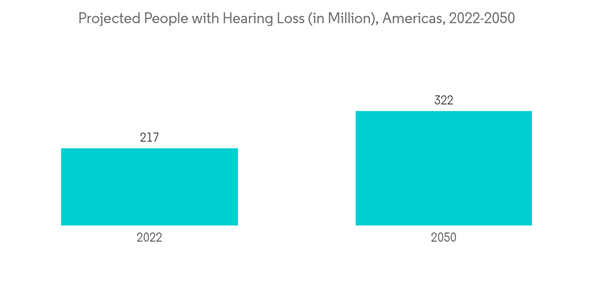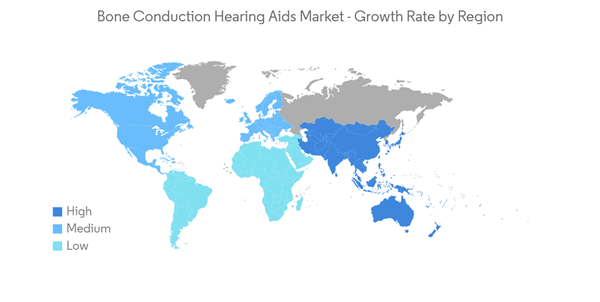Key Highlights
- COVID-19 impacted the growth of the market. The pandemic led to the shutdown of hospitals and clinics to avoid the spread of the coronavirus among the population. Also, during the pandemic, the American Academy of Audiology (AAA) recommended audiologists temporarily closed their practices, except for essential care and/or services that could be conducted via telecare or safe physical distancing. This impacted the market growth. However, with restrictions released and services resumed, the studied market was anticipated to grow over the forecast period.
- Factors such as the technological advancements in bone conduction coupled with the growing incidence of hearing loss in geriatrics, increasing healthcare spending, and the high demand for bone conduction hearing aids are expected to boost the market growth over the forecast period.
- The burden of hearing impairment in the geriatric population is relatively high, which is the key factor driving the market growth. For instance, according to the data published by World Health Organization (WHO), in April 2021, almost 25% of people over the age of 60 have debilitating hearing loss, which is more common in the elderly population. In addition, as per the same source, about 2.5 billion people are projected to have some degree of hearing loss, and at least 700 million are expected to require hearing rehabilitation by 2050 globally.
- Also, as per 2022 statistics published by the United Nations World Population Prospects, it has been observed that the percentage of people in the world aged 65 or older is expected to increase from 10% in 2022 to 16% in 2050. Thus, the expected increase in the elderly population further raises the risk of hearing impairment, which in turn is anticipated to fuel the market growth.
- The growing technological advancements in bone conduction hearing aids are expected to increase their adoption among the population who are either suffering from hearing loss or are deaf. For instance, according to an article published in the Current Otorhinolaryngology Reports in November 2022, the percutaneous osseointegrated devices offered the finest sound conduction and hearing fidelity. Also, the transcutaneous devices limit skin and wound complications, optimize bone conduction efficiency, and reduce the incidence of skin complications. Thus, the advantages offered by the advanced hearing aids are expected to increase its adoption, hence bolstering the market growth.
- Furthermore, rising product launches and approvals also contribute to the market growth. For instance, in March 2021, Cochlear Limited received United States FDA approval for the new Cochlear Baha 6 Max bone conduction sound processor, designed to improve hearing outcomes for people with SSD (single-sided deafness), conductive or mixed hearing loss.
- Therefore, owing to the aforementioned factors, the studied market is anticipated to grow over the forecast period. However, the disadvantages associated with hearing aids, such as pain and discomfort, as well as the high cost of bone-conduction hearing aids, are likely to hinder the growth of the bone-conduction hearing aids market over the forecast period.
Bone Conduction Hearing Aids Market Trends
Bone Anchored Hearing Aids Segment is Expected to Witness Significant Growth Over the Forecast Period
- The bone-anchored hearing aid (BAHA) is a surgically implanted device designed to help people with hearing loss and bypass particular problems by sending sound vibration directly to the inner ear through the skull bone. These work best for people who have at least one inner ear that functions normally.
- The prevalence of hearing loss among the older population is growing, leading to the high demand for adult bone-anchored hearing aids. Furthermore, growing awareness and advancements in technology in the diagnosis of hearing loss in infants and children are expected to boost the child/pediatric bone conduction hearing aids segment growth.
- The growth in healthcare infrastructure around the world and rising spending on healthcare are fuelling the adaptation of new technologies, which is boosting the market growth. The new innovations in bone conduction, such as ease of use, noise reduction, and increase in durability, change the phase of bone conduction hearing aids and further fuelling the market growth in the near future.
North America is Expected to Have the Significant Market Share Over the Forecast Period
- North America is expected to hold a significant share of the market over the forecast period owing to factors such as the rise in the incidence of hearing loss, the growing geriatric population, rising technological advancements, increasing product launches, and increasing government initiatives.
- The growing number of people suffering from hearing loss is expected to increase the demand for technologically advanced hearing aids, which is anticipated to fuel the market growth over the forecast period. For instance, according to the data published by the PAHO, in March 2022, about 217 million people were living with hearing loss in the region of America, representing 21.52% of the total population in 2022, and this number is projected to reach 322 million by 2050.
- Theincreasing aging population in the region is also contributing to the increased demand for hearing aids as they are more likely to develop age-related hearing loss. For instance, as per the data published by the Government of Canada, about three in five adults (60%) have hearing loss (23%), tinnitus (22%), or both conditions (14%)in 2021.
- Additionally, the rising government initiatives to provide funding for various hearing impairment diseases in the region are also contributing to market growth. For instance, as per the National Institute of Health, May 2022 update, the grant provided by the government for various research and development for hearing loss diseases in the United States was USD 162 million in 2021 and USD 168 million in 2022. Hence, the high research and development spending on diseases is expected to create opportunities for market players to develop innovative devices, thereby propelling market growth in the region.
- Furthermore, the rising company focuses on adopting various key strategies such as partnerships, collaboration, and others, as well as increasing product approvals and increasing the availability of technologically advanced products in the market, hence boosting the market growth. For instance, in January 2022, the United States Food Drug Administration (FDA) approved Oticon Medical, Demant's new bone-anchored product, Ponto 5 Superpower, in the United States.
- Also, in September 2021, the Malala Fund partnered with the Cochlear Foundation, a non-profit dedicated to hearing health, to promote awareness of the obstacles that prevent millions of children and teenagers with hearing loss from accessing high-quality education. Thus, such awareness programs will shift the focus of people towards bone-conduction hearing aids and their efficacies, which is expected to increase the adoptability of these devices and therapies, thus driving the market.
- Therefore, due to the aforementioned factors, such as the increasing government funding, increasing incidences of hearing loss coupled with an aging population, and rising company activities, the studied market is expected to grow over the forecast period.
Bone Conduction Hearing Aids Industry Overview
The bone conduction hearing aids market is highly consolidated owing to the presence of a few key players. Some of the key companies in the market are Cochlear Limited, Oticon Medical, Medtronic plc, MED-EL, and BHM-Tech Produktionsgesellschaft mbH among others.Additional Benefits:
- The market estimate (ME) sheet in Excel format
- 3 months of analyst support
This product will be delivered within 2 business days.
Table of Contents
Companies Mentioned (Partial List)
A selection of companies mentioned in this report includes, but is not limited to:
- Cochlear Limited
- Oticon Medical
- Medtronic plc
- MED-EL
- BHM-Tech Produktionsgesellschaft mbH










